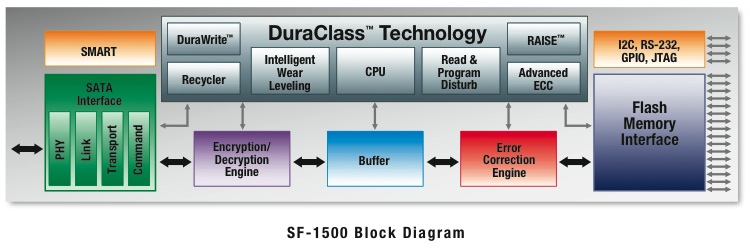MLC SSDs to Challenge Faster SLC Drives
A company called SandForce is in the last stages of prepping its new SF-1500 SSD processor for the mainstream. According to SandForce, its new SSD processors will give lower-cost, and slower MLC-based SSD drives a huge performance boost.
Right now, you can opt for two types of SSDs, SLC and MLC drives. With SLC drives, you'll get faster performance but you lose out on capacity, and prices are significantly higher. This is the main reason why SLC drives, like the Intel X25-E, remain largely in the hands of enterprise customers. Consumer SSD drives are largely based on MLC technology, which uses stacked memory cells to achieve higher capacity at the expense of performance.
SandForce claims that its new SF-1500 controller will not only introduce smart wear-leveling technology, but boost performance significantly. At this time, the controller supports drives up to 512 GB over 3 Gb/sec. SATA with native command queuing (NCQ). The controller will also support SLC drives.
According to the specs:
Max Capacity Supported: 512GB* (using 32Gb/die components)
Performance: Sequential Read Transfer: 250MB/s (@128K blocks)
Sequential Write Transfer: 250MB/s (@128K blocks)
Random Read & Write IOPS: 30,000 (@4K blocks)
We spoke to Intel, and were informed that its MLC based X25-M does 35,000 IOPS for random access, which is still a bit faster than SandForce's numbers. The controller does give a good boost in sequential write performance when compared with drives using IndilinX controllers like OCZ's new Vertex SSD, which tops out at 180 MB/sec. for its 120 GB Vertex.
Hopefully this brings the death of Jmicron's controller.
Get Tom's Hardware's best news and in-depth reviews, straight to your inbox.
-
Rancifer7 Anything that will bring the price down and performance up for these drives is a good thing in my eyes. Now lets see if what they are saying has any real world merit.Reply -
judeh101 smart wear level... now, everyone will need that technology!Reply
it's like having a re-allocated sector in SMART. -
SpadeM "with native command queuing (NCQ)." How can it have NCQ when that is a feature made specifically for old school hdds that have moving parts.Reply -
TheFace I thought that wear leveling technology was common in previous drives. The drawbacks of not having it are well known, as the write/erase cycles in MLC drives are limited to around 100k. If I recall correctly, I'm pretty sure the intel controller has this already, and I would be surprised at any controller that didn't.Reply -
lamorpa SpadeM"with native command queuing (NCQ)." How can it have NCQ when that is a feature made specifically for old school hdds that have moving parts.1) Look up NCQ 2) Study it's meaning 3) Then comment.Reply -
judeh101 NCQ means doing things in order to make it operate more efficiently.Reply
but however, this may slow down hard dives, I dunno about SSDs. -
judeh101 falchardI am still waiting for these SSDs to cost $70 for 500 GB.I agree with falchardReply -
thomasxstewart BE O/s BEOS, Batch Enhanced O/S. One "Native" command is BEEP. Whoaboi, Complex, when beeptime arrives, you canmake it longer, higher, repeateded multi beeping & even echo, You Choose from code libary, YOU MAKE QUE OF INSTRUCTIONS. In NCQ, Memorysystem Takes Over For You, Forward Slash / is Optional in Script-file BEEP. This was trouble with Batch Enhanced, You or your program Had To Write something, Sometimes or default, while software might NOT Be Coded Correctly in first place or Fragmentation. NCQ is ALL Machine.oPERATOR hAS no IDEA iF tHERE aRE even aNY /, Its Procol Demands NCQ RUN Correctly, ahso, SATA 6Gb/s should double speed OF ABOVE UNIT. It'll just be nice if it works, odds are VERY STRONGLY on NCQ. Other Cueing Protocols seldom are useful,Even if Primary; are disordered & disarraryed at ALL Times, while NCQ Just Keeps Hammering.Reply
Signed:PHYSICIAN THOMAS STEWART von DRASHEK M.D.
